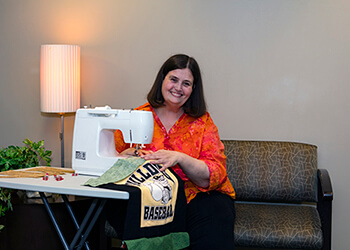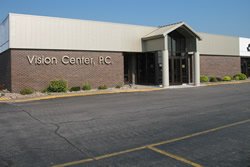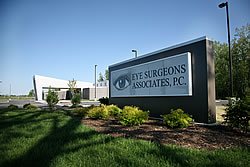It happens to most of us in our 40s. We need cheaters or bifocals to see close up. This condition called presbyopia happens even to people who have never worn glasses. And some people don’t ever want to wear glasses. Luckily, monovision is a way to correct presbyopia and can be achieved with contact lenses, LASIK or cataract surgery to reduce or eliminate your need for glasses.
Monovision corrects one eye to see clearly in the distance, if needed, and the other eye to see clearly close up. The eye that is set for distance should be the dominant eye – the eye one prefers to use to look through a keyhole or scope. It sounds strange, but the brain adjusts fairly quickly and most patients quickly forget they even have monovision.
Contact Lenses
A contact lens can be placed on the dominant eye for clear distance vision, and a different powered contact lens can be placed on the non-dominant eye to correct for near. And, if you still see fine for distance, a contact lens can be placed on the reading eye only. Contacts are an easy and temporary way to try out monovision.
When Eye Surgeons patient Theresa realized her near vision was starting to diminish, she got cheaters. Three pairs in fact because she seemed to always need them. Her work reading to children caused her to wear her cheaters most of the day. “I wore contacts for 15 years so I really didn’t want to start wearing glasses. The reading glasses were such a hassle for me so Dr. Etame suggested I try monovision with my contacts. I gave it a try and it took about a week to adjust. I did have a few slight headaches at first, which Dr. Etame said would be normal. But soon everything was great and I don’t even think about monovision now. The kids at school started asking where my glasses were. I was happy to tell them I didn’t have to wear them any more!,” explained Theresa.
Refractive Surgery (LASIK or PRK)
LASIK and PRK are laser surgeries, which change the thickness or shape of the cornea – the front surface of the eye – in order to correct the vision. With monovision correction, the dominant eye is corrected for clear distance vision, and the non-dominant eye for near vision. Refractive surgery with monovision is a great option for people in their 40s and 50s who have not yet developed a cataract.
Kelli is a patient of Eye Surgeons’ Dr. Kluver, who suggested she might be a candidate for monovision with LASIK surgery during a visit in 2011. “When I sew, I need sharp close up vision and glasses were always sliding down my nose. With a heavy quilt on my lap, it also felt hot wearing glasses. I was game to hear more about monovision and after a LASIK consult, I trusted the doctors’ recommendation that monovision was a good option for me. I’m so glad I did.”

When recalling the day of her surgery, Kelli says she doesn’t remember much about the actual procedure that only lasts about 30 seconds. “I was given a light sedative to relax and then it seemed like the surgery was over and I could already see better. It was really just that easy. I returned for my follow up and was back to my daily routine in no time at all. The doctors were exactly right when they said the brain quickly adapts to the mix of near and far vision and I didn’t have much of an adjustment period. It just worked. Now I only wear sunglasses.”
Cataract Surgery
Cataract surgery is needed when the lens inside the eye becomes cloudy over time, causing blurred vision and glare. This is exactly what Eye Surgeons’ patient Joyce experienced when cataracts quickly affected her vision. “At work, I was using a magnifying glass at the computer. It just seemed like I was looking through waxed paper. I didn’t realize how bad my vision had gotten until I was with friends who were all commenting about the deer in the distance. I had no idea there were even deer there!.”
Cataract surgery involves removing the natural lens from the eye (which is called a cataract when it becomes cloudy), and replacing it with an artificial lens, usually made of acrylic. The artificial lenses come in many different powers to correct the vision. If monovision is desired, measurements will be done to determine the necessary lens power to achieve distance vision in one eye, and near vision in the other eye. Cataract surgery with monovision is a great option for people who have blurred vision secondary to cataracts, and who desire to not wear glasses after surgery.
Monovision is very well tolerated by many patients. The brain adjusts and they feel they see clearly for both distance and near, without the help of glasses. Others have difficulty with the imbalance between the eyes, and feel they do not see clearly when not using both eyes to drive, or both eyes to read.
Joyce continued, “This is my vision and I was choosing to have surgery on my eyes. I wanted the best surgeon to do my procedure and I’m glad I chose Dr. Wagle. The surgery was easy, the drops were also easy and I was back at work right away. If your doctor suggests monovision, I say do it. Now I can drive without glasses and sometimes rely on cheaters for very fine close up tasks. I don’t even notice that I have monovision. And seeing vivid colors after the cataracts were removed was amazing to me. Things are no longer a blah yellow color.”

It is a good idea to try monovision with contact lenses prior to committing to monovision through surgery. If after monovision surgery you prefer to use both eyes for both distances again, glasses can be prescribed to balance the vision and it’s possible that LASIK can be done again on the near eye to change both eyes to distance.
Dr. Repp is a board certified ophthalmologist. She was an assistant professor in the ophthalmology department at the University of Iowa for two years. She has special interest in the surgical treatment of cataracts with the latest techniques. Dr. Repp practices at our offices in Bettendorf, Iowa and Rock Island and Silvis, Illinois. Click here to watch Dr. Repp further explain the three monovision options.
The material contained in this article is for informational purposes only and is not intended to be a substitute for professional medical advice, diagnosis, or treatment. Always seek the advice of your physician or other qualified health care provider.




